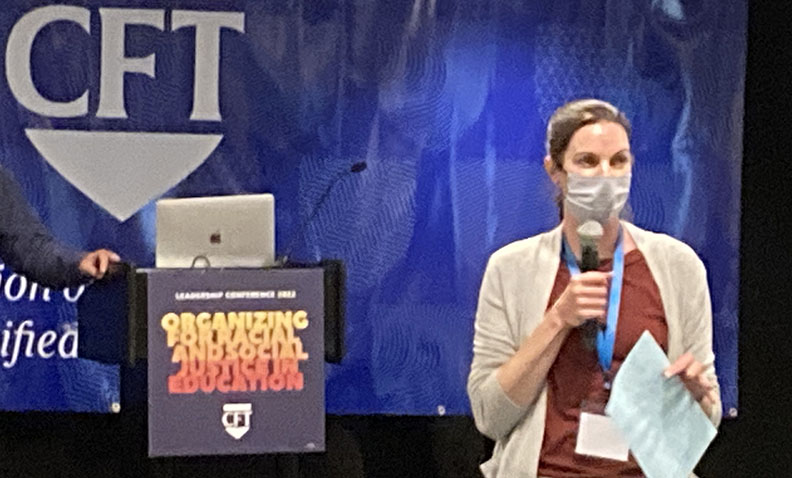Class size
CFT and Academic Senates collaborate on statewide campaign to enable discipline faculty to determine appropriate class size
By Katharine Harer, AFT 1493 Co-Vice President & Rika Fabian, Skyline Chapter Co-Chair
Faculty know from experience that large classes can have a negative impact on student learning. It’s been shown time and time again that individual attention is a key to student engagement and retention, and community college students often feel lost in large classes. Large classes tend to reduce the opportunities for students to receive qualitative attention from their instructors due to the unsustainable workload they create for faculty.
Additionally, large class caps harm adjunct faculty, leaving fewer classes in the schedule to assign to part-timers, who are often unable to make up their teaching load, resulting in big hits to their pocketbooks. Another issue is when classes don’t fill up to their stated cap and they’re cancelled. Adjuncts often lose a chance at getting another class to make up for a cancelled class because a full-timer needs to make up their load, which once again unfairly impacts adjuncts. In most cases, overly large classes do not benefit faculty or students.
Resolutions to be brought to State Academic Senate Plenary in April
Our AFT Anti-Oppression Committee helped to get the ball rolling on a statewide campaign to lower class sizes after Rika Yonemura-Fabian and Doniella Maher presented a class cap resolution at a CFT event in March 2021. Since July, community college union leaders across California have been meeting to map out a strategy to address this problem statewide. Led by Peralta Federation of Teachers’ President Jennifer Shanoski, and with the support of CFT staff, our local, along with local AFT unions at City College of San Francisco, College of Alameda, San Jose/Evergreen, Mission/West-Valley, Los Rios, Los Angeles, and others are working to get resolutions addressing class caps passed in the Academic Senates at our colleges.
 Peralta Federation of Teachers’ President Jennifer Shanoski spoke about the statewide class size campaign
Peralta Federation of Teachers’ President Jennifer Shanoski spoke about the statewide class size campaign
at the CFT Community College Council meeting on March 18 in San Francisco
A Resolution for Faculty Participation in the Creation of Class Caps for their Departments and Courses developed by the College of Alameda Academic Senate is one example. The goal is to bring these resolutions to the State Academic Senate Plenary in April and push for one strong resolution from the statewide Senate. In this effort, the Senate and unions are building a united front to work on this important issue.
Surveys on how class caps are determined around the state
At the same time, the statewide organizing group is testing a faculty survey, which is being sent to three of the largest locals in the state, to get faculty input about how class caps are determined in their departments and the impact on student learning and faculty working conditions. Once these survey responses are gathered, the plan is to have each of our locals run a similar faculty survey. Our union, through our Anti-Oppression Committee, created a comprehensive survey on the issue in May 2021 that garnered nearly 200 responses, followed by our three senates and our district senate passing resolutions on increasing faculty input in the determination of class size.
Union contracts need to ensure role for faculty in determining class size
The union leaders who are working on the class cap issue agree it would be best if our locals could get language into our union contracts that ensures faculty input in determining class size, rather than basing class caps on past conventions or the whims and numerical goals of administrators. Mission/West Valley has been able to bargain and win language in their contract that gives faculty a role in making these decisions.
We’ll keep you posted about how the campaign develops and let you know what you can do to help with this push to lower class caps so that they are faculty-driven, reasonable and pedagogically sound.
